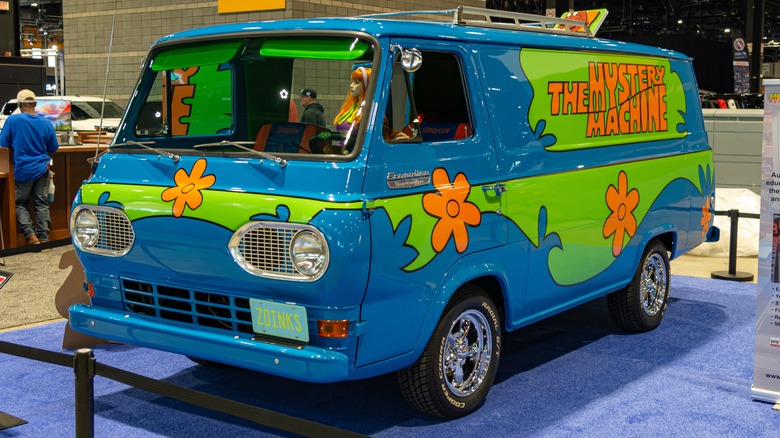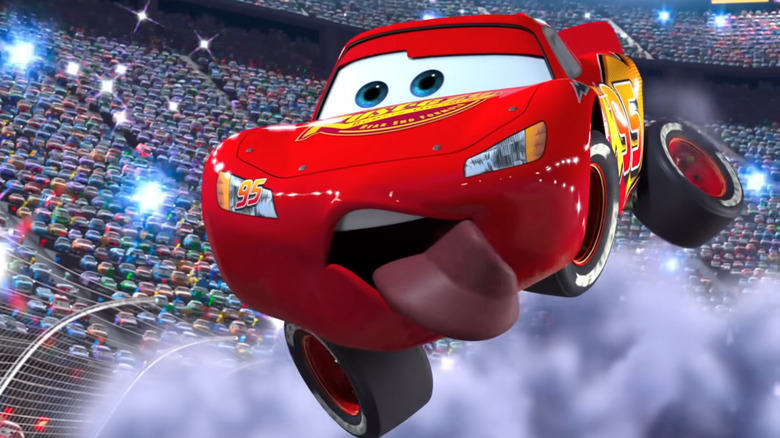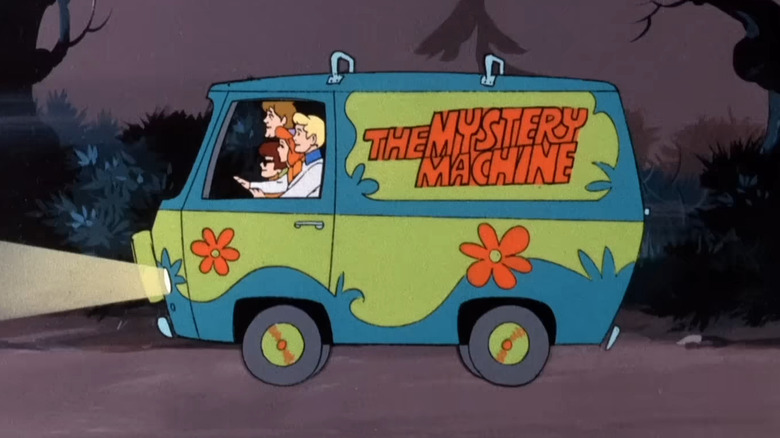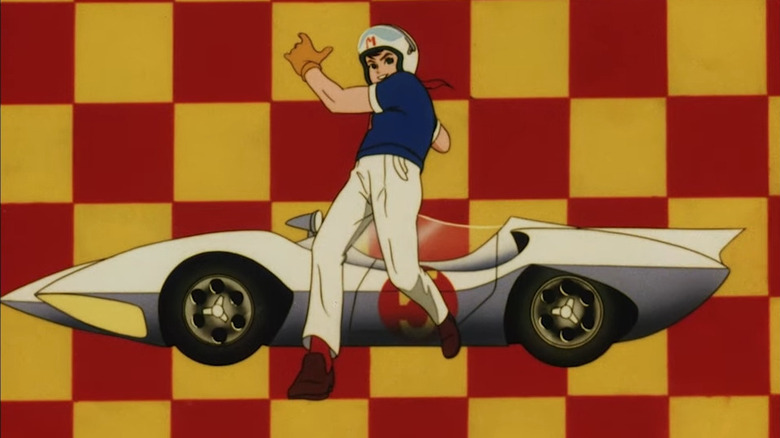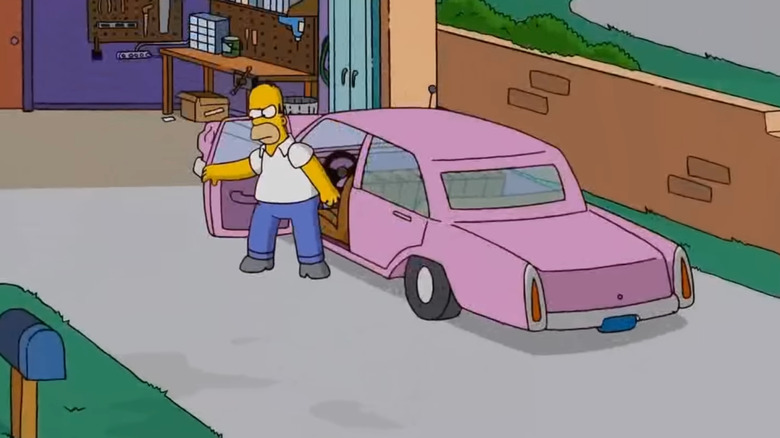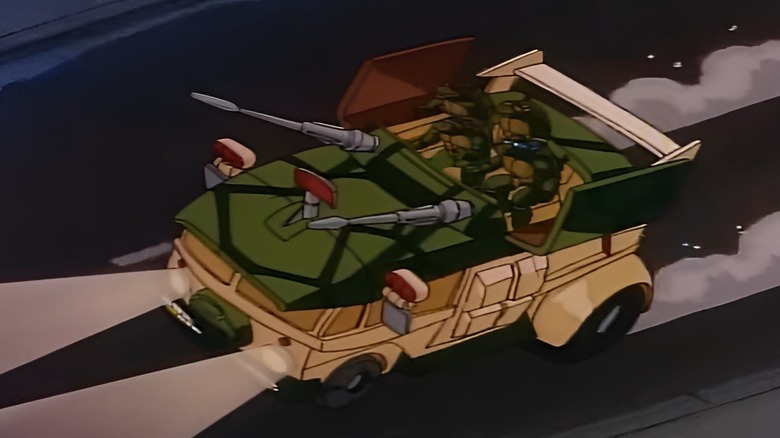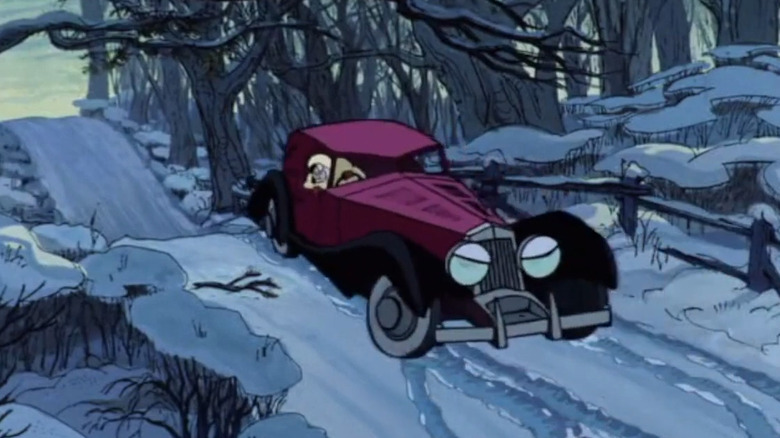6 Beloved Cartoon Vehicles (And The Real Cars They Were Based On)
Whether you camped out by your TV to binge Saturday morning cartoons, rewound your favorite Disney VHS over and over again on lazy afternoons, or even stayed up late at night to be traumatized by what Adult Swim had to offer, there's a good chance that animation was a major part of your childhood. Animated movies and TV shows have the power to transport viewers to imaginative new worlds while conveying rich themes and emotional subject matter in an unmatched universal manner. Most importantly, it's an exciting visual art form that can transform the mundane, everyday elements of our world into something unforgettable.
For plenty of car aficionados, the spark that got them excited about the world of automobiles was a fictional car from their favorite cartoon. But just like other elements in animation, most cars you'll see in cartoons weren't created out of the blue. To add believability, animators will often use real world figures, places, and objects as a starting point before finding places to appropriately exaggerate and caricature.
This is the case for many animated vehicles, which often use real rides as their basis. Keep reading to learn about more of some of the most iconic cars from your favorite animated works and the real life automobiles they're based on.
Cars: Lightning McQueen
The 2006 animated hit Cars and its many sequels have been responsible for a whole new generation of gearheads. There's no shortage of diverse vehicles populating the popular Pixar franchise, from high-performing race cars to rusty tow trucks to 70s-era Volkswagen vans and everything in between. But pinning down the inspiration behind the series protagonist, Lightning McQueen, is not as easy as you might think.
Designing the self-centered racer turned humble small-town resident of Radiator Springs was no small feat. To imbue Lightning McQueen with the right blend of confidence, spunk, and determination appropriate for a hot shot race car driver, the Pixar team took inspiration from a wide range of race vehicles. In an interview with the Los Angeles Times at the time of the film's release, director John Lasseter stated that McQueen was, " ... a hybrid between a stock car and a more curvaceous Le Mans endurance racer ... with some Lola and some [Ford] GT40." It's easy to see the sportiness, aerodynamic qualities, and rounded design common in such cars as the Ford GT, Chevrolet Corvette C6, and Dodge Viper reflected in McQueen's design. Even if their distinct headlights, fenders, and hood shapes were more popular in this era, their characteristics have lived on in the ever popular world of "Cars."
Scooby Doo: Mystery Machine
For decades, Scooby Doo and gang have been solving mysteries and unmasking bandits. But the beloved meddling kids and their dog could not have gone nearly as far in their crime-solving capers if it weren't for their ever-reliable van, the Mystery Machine. Sporting a psychedelic blue and green paint job with orange lettering and flower decor, the Mystery Machine is not only an unmistakable fixture of the Scooby Doo franchise, but stands as an everlasting symbol of 1960s youth culture.
Like many cartoon cars, the true identity of the Mystery Machine has remained a mystery in and of itself. As the original series "Scooby Doo, Where Are You!" was released in 1969, the van takes obvious cues from similar vehicles from that time. Careful examination from viewers suggests that the Mystery Machine might be a hybrid of a Dodge A100 and a Chevy G-Body, two van options that originated in the mid 1960s. In particular, it shares color, headlight shapes, and bumper similarities to the former while sporting the angled windshield and lack of rear view mirrors common in the latter.
Later interpretations of the Mystery Machine went down different avenues. The 1998 direct-to-video animated film "Scooby Doo on Zombie Island" appears to be modeled after a Chevy Astro minivan while the 2002 live-action film utilized a 1972 Bedford CF to bring the Mystery Machine to life.
Speed Racer: Mach 5
In Gô Mifune's efforts to become the greatest racing champion, he needs a car that can get the job done and then some. What he hops into is the Mach 5, which more than fits the bill. High tech doesn't even begin to describe the iconic race car from the hit anime "Speed Racer." Its extensive functions include night vision, underwater driving capabilities, rotating blades, a bullet deflector, and auto jacks that allow the car to jump over obstacles.
Perhaps its for the best that the Mach 5 doesn't exist in real life. There's no denying the impact of this timelessly appealing hot rod, which began cruising across TV screens in 1967 and has since appeared practically unchanged in several followup "Speed Racer" shows and the 2008 live-action film adaptation. Initially created by manga writer and illustrator Tatsuo Yoshida, art director and designer Mitsuki Nakamura purposefully chose to make alterations to the Mach 5 for the series using a mix of cars.
Describing his process and influences in a 2007 interview, Nakamura shared, "I couldn't come up with a shape, so I searched through photos of race cars from that time, mixing in Porsches, Ferraris, and things like that. And that's how it ended up in that form." He added the concave lines of 60s era Ferraris and headlights of Porsches (which he flipped upside down for the final design) were key elements the team honed in on when creating to soon-to-be beloved vehicle.
The Simpsons: Pink Sedan
Not every cartoon car has to be super-powered, be involved in mystery-solving escapades, or possess life to stamp out a place in pop culture. And even though "The Simpsons" has featured plenty of cool cars in its over three decades of television domination, the pink sedan that barrels through Springfield at the start of every episode is one that even non-fans can recognize. Yet, for much of the show's run, we were left scratching our heads as to the true identity of the iconic vehicle, made difficult by its commonplace 1980s appearance that lacks any distinct features. It wouldn't be until nearly 30 years into the show's run that we got an answer.
In the Season 28 episode "Pork and Burns," it's revealed that Homer's car is a 1986 Plymouth Junkerolla. Of course, this isn't a real car from the Chrysler nameplate, but rather a fictional creation that's been suggested to be made up of pieces from Soviet tanks. In certainly resembles a Plymouth in many ways, with many fans most closely linking its features to a Plymouth Valiant or Reliant. Whether or not this is the true inspiration for the famous pink car has yet to be confirmed by the show's creators.
In October 2024, Michigan-based real estate agent and part-time mechanic Tim Updyke became the envy of "Simpsons" fans everywhere when he created a near-perfect real-life replica of the Junkerolla, complete with the fender dent and bent antennae. The vehicle used to recreate the cartoon car was a 1967 Plymouth Valiant, further validating fans who picked up on the influence.
Teenage Mutant Ninja Turtles: Turtle Van
As counterintuitive as it might seem for ninjas to traverse about the city in a big, noisy vehicle, it's hard to imagine the titular heroes in a half shell from "Teenage Mutant Ninja Turtles" going about any other way. While the Turtle Van originated in the original Mirage Studios comics by Kevin Eastman and Peter Laird as a more basic Volkswagen van, it received a drastic makeover for the 1987 animated series that has carried into' later interpretations.
The vehicle originally belonged to regular series antagonist Baxter Stockman before being taken by the turtles in an effort to reach Shredder's base. While initially being little more than a typical van, Donatello's alterations result in it becoming a high-class machine fitted with numerous gizmos and gadgets made for fighting crime and tracking down enemies. The Turtle Van, also commonly referred to as the Party Wagon, was originally designed by famed toy designer Mark Taylor. Taylor took note of the simplicity of the original comic book vehicle, which bore a striking resemblance to a 1980 Volkswagen Vanagon L, and went about adding his own flourishes to the design.
The franchise would see many other variations of the Turtle Van over the decades, from a 1967 Ford Econoline in the 2014 live-action "Teenage Mutant Ninja Turtles" movie to Subaru Sambar in the animated "Teenage Mutant Ninja Turtles: Mutant Mayhem" film.
One Hundred and One Dalmatians: Cruella De Vil's Coupe
Good guys aren't the only ones with stylish rides. And if anyone knows a thing or two about style, it's Cruella de Vil from the 1961 Disney classic "One Hundred and One Dalmatians." Even though it's impossible to sympathize with her plan to murder innocent Dalmatian puppies and cover her body in their spotted hides, there's no denying that the devilish diva knows how to leave an impression. And that's definitely the case for her one-of-a-kind coupe.
Sporting a distinct magenta and black coloration and a long sleek look, Cruella's car perfectly encapsulates her classy femininity and sinister nature, made all the more blatant by her unapologetically wild road rage. It's clear that Cruella is confident in her aesthetic too, as her car is no trendy ride of the era, but rather takes inspiration from various cars that were decades old by that point. Many believe that the vehement vehicle is based on cars from the 1920s and 1930s, such as the 1929 Rolls-Royce Phantom II Continental and the 1935 Bugatti Type 57. The exaggerated features present in cars from this era of automobile history lend themselves perfectly to de Vil's larger-than-life persona and help imbue her car with loads of character.
